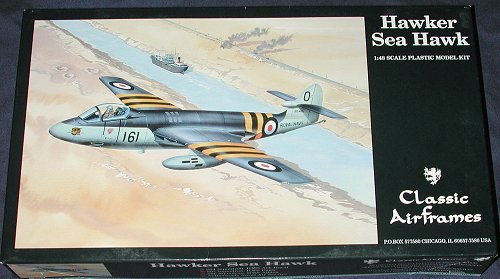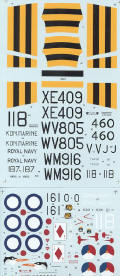
|
KIT: |
Classic Airframes 1/48 Hawker Seahawk |
|
KIT # |
465 |
|
PRICE: |
$55.00 MSRP |
|
DECALS: |
Several options |
|
REVIEWER: |
Scott Van Aken |
|
NOTES: |
Includes resin and etched metal parts |

|
HISTORY |
Based on the Hawker P.1040 prototype, the Sea Hawk had development begin in 1944, and 17 years later, was still in service. The aircraft was developed around the Rolls-Royce B.41 jet engine and was to have bifurcated inlet and exhaust ducts, leaving the nose clear for weapons. This early in the development of turbojets, much research was going into proper inlet/exhaust operation and lengths. In those days, too long an inlet would result in the loss of power so a happy medium needed to be sought between ideal engine placement and inlet design.
By late 1945, the General Staff didn't see the P.1040 as being much of an improvement over the Gloster Meteor IV, but the Navy was interested and so Specification N.7/46 was drawn up to cover the three prototypes. The first prototype, VP 401, first flew in September 1947 and was generally an acceptable aircraft. This aircraft was followed by a navalized aircraft, VP 413, the first Sea Hawk prototype. The wingspan was increased by 30 inches to lower stall speed and the aircrafts speed of around 500 mph was considered to be quite good for a naval fighter. Deck trials aboard the HMS Illustrious concluded in late 1949 and gunnery and other trials commenced early in 1950. By this time 151 aircraft had been ordered, the only real change was the addition of an 'acorn' fairing at the leading edge of the tailplane/fin join to help smooth out airflow over the tail surfaces.
By 1953, the first operational squadron (806) received Mk.I aircraft and embarked upon the HMS Eagle later that year. Other squadrons were to follow. It was decided that Hawker was unable to meet the demand for aircraft so production was switched to Armstrong-Whitworth, who did all further development on the aircraft.
Developments included the F.B.3 which added under wing ordnance, and the FB.4 which had a slightly uprated Nene engine, and added vortex generators on the tailplane to increase handling. The FGA 5 and 6 were given even more powerful engines, several of the FB.3 and 4 airframes being updated as well as new builds added.
The Sea Hawk's claim to fame was its involvement in the Suez Crisis of 1956, which was basically ground attack sorties against Egyptian air bases. By 1958 it was being replaced by the Scimitar and by 1960 it was all but gone from the inventory, save for a few test aircraft.
|
THE KIT |
 Opening
the box, one is presented with two large and one small plastic sprue.
There is also a one-piece canopy that is injected and crystal clear. A
bag of resin goodies and a fret of Eduard etched metal are also in there.
Two large decal sheets and a set of instructions concludes the 'bits in
the box.
Opening
the box, one is presented with two large and one small plastic sprue.
There is also a one-piece canopy that is injected and crystal clear. A
bag of resin goodies and a fret of Eduard etched metal are also in there.
Two large decal sheets and a set of instructions concludes the 'bits in
the box.
The forward portion of the airframe is split horizontally, while the aft section is split vertically. Most of the major airframe and landing gear parts are in plastic, which is superbly molded with nicely engraved detail. A few ejector stubs to clear up, but no sink areas and no flash.
 The
outer wings are separate, and it is obvious by the resin and metal bits
that this model can be built with the wings folded. The etched bits
include the outer wing fold rib, instrument panel, seat harness, and
intake splitter plates among the biggies. Resin covers the main wheel
wells, seat, various control boxes, wheels, exhaust, inner wing ribs, and
the intakes. The resin is superbly cast with none of my parts exhibiting
any readily apparent glitches. There is also a small acetate sheet for
the instrument.
The
outer wings are separate, and it is obvious by the resin and metal bits
that this model can be built with the wings folded. The etched bits
include the outer wing fold rib, instrument panel, seat harness, and
intake splitter plates among the biggies. Resin covers the main wheel
wells, seat, various control boxes, wheels, exhaust, inner wing ribs, and
the intakes. The resin is superbly cast with none of my parts exhibiting
any readily apparent glitches. There is also a small acetate sheet for
the instrument.
Instructions are excellent, providing detailed construction steps as well as providing any color information needed. There are several hints and helpful suggestions, which would be advisable to read and are a real help for those not totally used to multi-media kits. Nose weight is required to keep this one from tail sitting and there is lots of room for it behind the cockpit. There are two options; one for folding wings and the other for carrying the drop tanks and/or bomb racks. No bombs are provided, but finding some shouldn't be too big a problem. It would have been nice to have rockets and rocket rails as well, but you can steal those from an Airfix late model Spitfire if you must have them.
Markings are provided for several aircraft, all in Extra Dark Sea Grey over Sky, except where noted. First off is an FB.3 from 897 Sq in 1956, next is a Dutch FGA.50 of 860 Sq in the early 1960s. Third is an 806 Sq FGA.6 with a white underside in place of the Sky. Finally, the box art aircraft from 804 Sq aboard the HMS Ark Royal during the Suez Crisis of 1956. The sheet includes the full Suez Stripes and I recommend applying any bomb racks after applying these decals. The decals are superbly printed by Microscale, so you know that you are getting the best there is.
|
CONCLUSIONS |
You can now toss your still-nice Falcon vacuform kits as this one just is that much nicer. Those who have been awaiting a very nice 1/48 Sea Hawk, don't have to wait any longer. It is a superb kit and test fitting some of the parts shows that it should be a pretty hassle-free build. As with any kit of this type, I'd recommend that you have some experience with the genre before diving into it. I've already started clean-up and some assembly so stay tuned!
|
REFERENCES |
Hawker Aircraft since 1920, by Francis K Mason, 3rd Edition, 1991, ISBN 1-55750-351-6
Review kit courtesy of
 Thanks for your support.
Thanks for your support.
If you would like your product reviewed fairly and quickly by a site that has over 250,000 visitors a month, please contact me or see other details in the Note to Contributors.